Shrub with red leaves and yellow flowers. ornamental shrubs
Barberry Thunberg Aurea
Height: 0.8 m Annual Growth: 10 cm
Crown shape: wide round compact
Peculiarities: lemon-yellow leaves in summer, orange-yellow in autumn. Likes alkaline soil, not picky about fertility. Grows well in full sun or partial shade. In the first 2 years after planting, shelter is necessary with spruce branches. Grows slowly.
landscape use:
The beauty of the narcissus lies in the lightness and transparency of its petals, that is, in the perigone; the real flower is the crown, which can be the same color as the perigone or a contrasting color. If grown in the garden, daffodil bulbs go underground in autumn; they are rustic and do not like to stay away from the ground for a long time, so it is best to dig into them and forget about them in the light, but not in the damp ground; you can multiply every three to four years by dividing the bulbs. The blooms are breathtaking every spring if you want the leaves to be shaved naturally and hand out a handful of granular fertilizer to the flowering plants after the blooms are over.
Barberry Thunberg Maria

Height: 1.5 m Annual Growth: 10 cm
Crown shape: columnar
Peculiarities: the leaves are round or oblong, orange-red when blooming, bright yellow in summer with a carmine rim around the edge. Autumn color is orange to purple.
landscape use: hedges, rock gardens and rock gardens, mixborders.
Bring them back to bring bouquets home; they are so fine that any container is good, but they reach their maximum effect in transparent or globular jars or in containers of antique taste, aged zinc or ceramics. If you forgot to bury some bulb in the garden or in the house for sitting in autumn, you will find bullet pots ready to flourish during this period; don't forget to make them bloom complete or give them to those who have a garden.
Give it plenty of space in a well-drained garden area by generously polishing the first year in which it grows very quickly and expanding its hairy, evergreen hair and feathery feathery leaves. It is replete with golden clusters, very fragrant. After flowering, it must be baked decisively.
Barberry Thunberg Special Gold
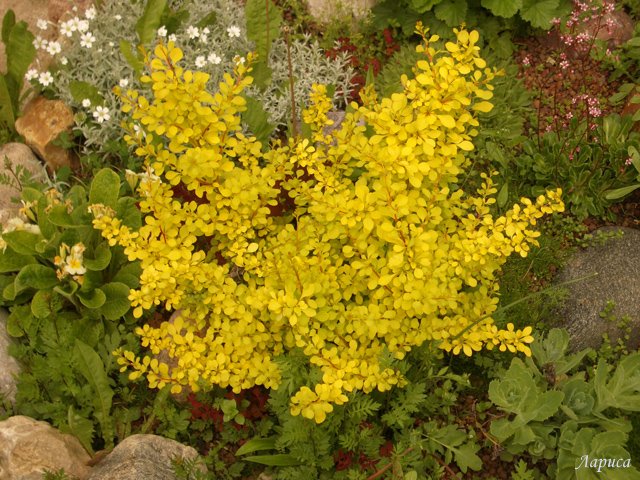
Height: 0.3 m Annual Growth: 10 cm
Crown shape: rounded
Peculiarities: yellow-green leaves, prefers a sunny location. Grows on any soil.
landscape use: low hedge-curb, rocky gardens and rock gardens.
Cultivated with shrub or even a little rock climbing, in March the bare branches are covered with single or double flowers, white, red or pink; they follow dark green leaves, small and oval. The plant is thorny and also suitable for making mixed protective hedges as well as hawthorn and dog roses. Take a few branches to bring them home in a vase, beautiful everywhere with their appearance of miniature roses. Fruits that cannot be eaten raw can be used for garlic or as a thickener for homemade jams.
Black elder Aurea
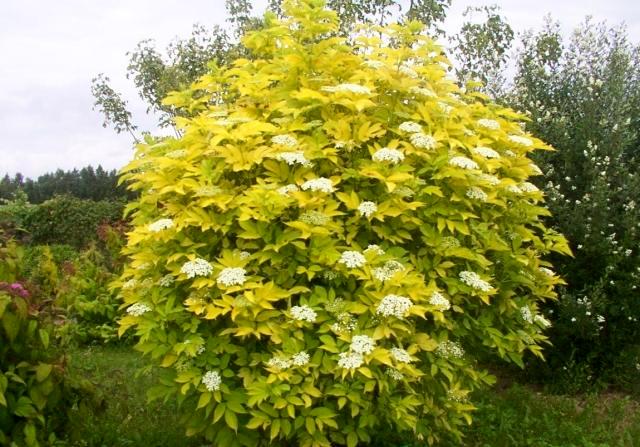
Height: 2.5 m Annual Growth: 40 cm
Crown shape: domed
Peculiarities: large shrub with large leaves, blooms from July for a month with creamy fragrant flowers. The fruits are black berries. Grows on any soil, tolerates flooding. It grows very fast. Handles haircut well. Honey plant! Every 3 years it is recommended to cut "on the stump" to form a beautiful bush.
landscape use: as a tapeworm, a wide hedge, in urban gardening.
Philadelphia is very thick in old gardens, philadelfo is a shrub of pure ethereal, pure white color, with a very intense orange blossom scent. In a flower, the tongue is the flower of memory, perhaps because the most vivid memories are associated with smells. A simple, robust and generous shrub planted in the garden in March adapts to any soil, sun or shade, it also resists very dry climates and is resistant to vermin. Philadelphia thrives on last year's branches, so it's a good idea to sharpen it up after flowering to encourage the production of new branches that will bloom next spring.
Vesicle viburnum Darts Gold

Height: 1.5 m Annual Growth: 20 cm
Crown shape: hemispherical
Peculiarities: Foliage is yellow-orange in spring, yellow in summer. It blooms from mid-June with numerous white flowers for 3 weeks. Likes sun or partial shade, grows on any soil, preferably acidic. Old shoots must be cut. Grows fast.
landscape use:
They grow easily in any type of soil, in sun or shade, in summer like water. They can be cultivated both in the ground and in terrace baths, where it is good to plant a waiting variety, with thin branches and pendants to fall outside; Fascinating and pale cultivar, with flowers of delicate yellow light. The plant should be roasted immediately after flowering, use some branch ready for flowering to put in a pot. Broken branches for a long time in the water. Long and architectural, they are very decorative; Choose a container high enough and change the water every two to three days.
Vesicle viburnum Luteus
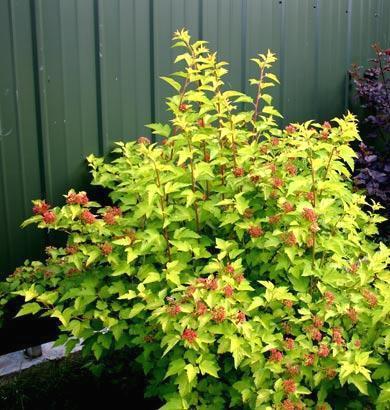
Height: 3m Annual Growth: 40 cm
Crown shape: hemispherical
Peculiarities: leaves are golden-orange in spring, green in summer, yellow in autumn. Everything else - as in the previous vesicle.
landscape use: like a tapeworm, a wide hedge.
The leaves are small, about 2 cm long and 1 wide. Having a great effect both individually and planted in mass, it is easily multiplied by the pollen that is born at the base of the bush; since it blooms on last year's branches, it must be bred after flowering.
And now, you have the floor: do you like these views? What flowers will enrich your home or garden this time of year? It originates from the eastern regions of North America, but has long been cultivated in Bulgaria as a shrub throughout the country and has grown. This is very good, both long droughts and floods. Blooms in sunny places from June to August. It is distinguished by its thin straight twigs, its tea leaves consisting of 11-25 elliptical oval leaves. The flowers are small, crimson, with golden yellow stamens.
Japanese spirea Golden Carpet

Height: 0.3 m Annual Growth: 15 cm
Crown shape: hemispherical
Peculiarities: dwarf tender shrub with yellow-green foliage. It blooms with a few flowers in summer, from July to October. Prune in early spring from the age of 4 - 15 cm from the soil surface - to maintain a neat shape of the bush.
landscape use: low hedges, borders, rocky gardens and rock gardens, flower beds.
thick spike
They are collected in dense, inflorescences - brooms. Amorphousness is necessary for soil conditions. During flowering, bees are widely visited. As a honey plant, it is worth planting on slopes, embankments, poor soils or floodplains. Thistle thistle is restricted in the country, and its collection as medicinal plant governed by an annual ministerial order environment and water resources.
Autumn leaves leaf color is yellow. Flower colors are yellow and orange. Flowering period - June - September. It survives directly in the sun and in the sun. Irrigation is not enough and soil conditions are needed. Propagated by stem cuttings and seeds. Decorative effect - long red stamens.
Japanese Spiraea Golden Princess

Height: 0.6 m Annual Growth: 15 cm
Crown shape: hemispherical
Peculiarities: leaves are oval-pointed, bright yellow in spring, light yellow in summer, orange-yellow in autumn, blooms from July to September. Grows well in full sun or partial shade. Pruning in early spring from 4 years of age.
landscape use: hedges, rock gardens and rock gardens, shrub groups, flower beds
Japanese quince
Number of plants per linear meter: 3 to 4 Suitable planting time: April, early October is best. Spring Hennelis is decorated with large red-orange flowers and autumn with yellow-green edible fruits. It reaches a height of 1.5 m, so it can be used as a low hedge. The plant tolerates a lack of moisture in the soil very well.
Resistant to industrial gases. It has a strong cut, but blooms better with natural natural growth. Frozen fruits make delicious jelly. About 60 different species are known, with the exception of white, pale pink and even red. In Bulgaria, predominantly healed and fluffy breeding crops are grown.
Spiraea japonica Goldmount
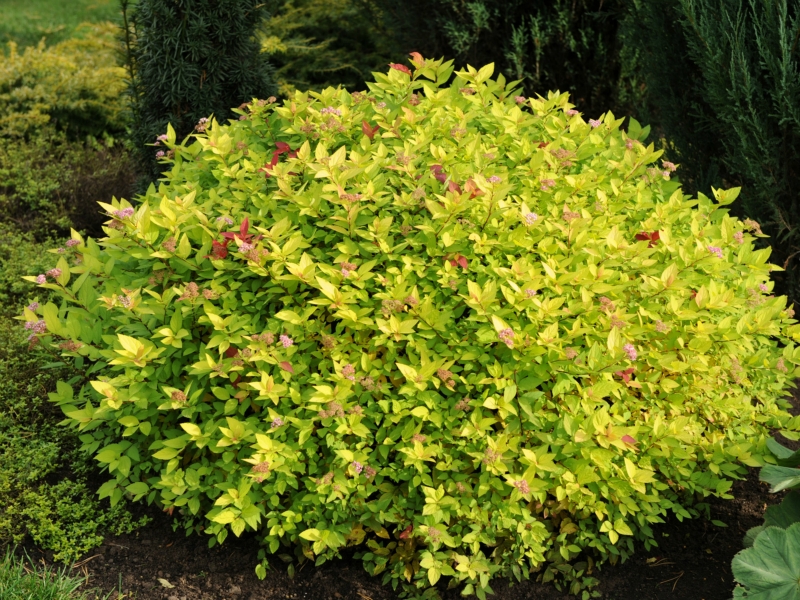
Height: 0.5 m Annual Growth: 15 cm
Crown shape: hemispherical
Peculiarities: Leaves are light yellow in spring, yellow-green in summer. Blooms from July to September. Pruning in early spring from 4 years of age.
landscape use: low hedges, borders, rock gardens and rock gardens, flower beds
Blooms actively in summer for 20 days. It is resistant to weathering and irrigation. In early spring, no bush can compare in beauty with the golden yellow flowers of forzan, the most popular variety of which is called "golden rain". While other buds and shrubs are starting to appear, the branches of the silos are covered in relatively large flowers, with all shades of yellow or orange, even before they are completely dispersed. In summer, the leaves are dark green, and in autumn they turn bright purple-yellow tones and do not fall for a long time.
Education is a light-loving plant, does not require soil and can withstand drought. If the winter is very hungry, it can also freeze, but it recovers quickly and can produce colors in the same year. The garden can be grown in groups as well as a single shrub.
Japanese spirea Goldflame
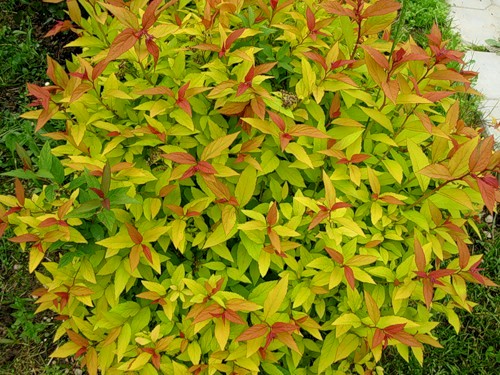
Height: 0.8 m Annual Growth: 15 cm
Crown shape: hemispherical
Peculiarities: in spring and autumn, the ends of the shoots have a red-orange color of the leaves, in summer the foliage turns yellow. In autumn, on acidic soils, the leaves turn red. Grows well in full sun or partial shade. Blooms from July to August with pink flowers. Pruning in early spring from 4 years of age.
landscape use: hedges, tree and shrub groups
Lepidopter bush with hanging branches and blue-green leaves. It grows with countless overgrown, dark yellow, small-like petals in early summer. Lightweight, dry and resistant to soil conditions. This shrub sometimes reaches a height of 5-6 meters. It has bright green oval leaves up to 10 centimeters long. They bloom in single flowers, smaller than China rose and in various decorations, from white to crimson, sometimes also in two colors. He likes a lot of light, heat and moisture.
Indian lagerstroemia
When these conditions are present, it blooms brightly from the second half of summer to early winter. It grows well in partial shade, but then blooms weaker. In the cooler regions of our country, waiting is in vain. The colors, depending on the variety, are white, pink, red or purple and beautifully curved, appearing only at the tops of the thick annual stems. The dark green leaves are elliptical or oblong, the branches are four-stranded, and the stem shines like silk.
It is best, of course, to first sketch out the garden of your dreams on paper, playing with different options for shapes and colors until you find the most interesting option. So in summer, when green color dominates in the landscape, plants with colored foliage will give a pleasant effect to the garden. In the color palette of foliage, there are mainly three groups of bright colors - yellow, dark red and grayish-white tones.
The flowering period is from August to October. Masturbation: Sunny and initially sheltered from the wind. It is best to reflect light and heat in front of a white wall. The climate in Bulgaria has cold winters and the leaves fall off and reappear in the spring. Not attractive for watering and caring for special plants. Shrubs are the perfect backdrop to create a sense of stability. We will do this better by choosing plants of different heights and shapes and strategically distributing them. Bushes that bloom with bright colors are combined with those whose flowers are rather pale.
Shrubs may be ornamental in shape or flowers that are often scented or colored leaves, often with their ornamental fruits. General form not in last turn refers to stems that often have a characteristic texture. Shrubs are plants with woody stems that usually branch from the base and form a series of lateral stems directly from the ground or slightly above its level. This is different from trees, which only have one stress, but the two groups overlap to a certain extent.
Bright and showy ornamental deciduous shrubs.
Shrubs with yellow foliage.

Woody plants with yellow foliage are very enlivening garden composition, but since yellow is the first color that catches the eye, its inclusions must be carefully considered. So, ornamental shrubs with golden foliage are recommended to be planted in a sunny or slightly shaded place. For example, large color spots can be obtained from black elderberry (Sambucus nigra) variety "Aurea" (bush up to 3 m high and wide; needs humus soils). Approximately up to 2 m grows white turf or white pork (Cornus alba) varieties "Aurea" and "Aureovariegata" (this variety has yellow-green foliage), as well as vesicle Kalinolistny (Physocarpus opulifolius) grade "Dart" s Gold",'Minange', 'Nugget' . If necessary, plants can be shaped by cutting in the shape of a hemisphere and thereby maintaining the required height. The crown (jasmine) mock orange (Philadelphus coronarius) variety "Aureus" with golden foliage, reaching a height of up to 2 m, looks very impressive. Diabolicum, Sunsation , growing up to 1m.
Some of the ornamental shrubs look interesting for several seasons, others only one. They are mostly readily available and there is not much work to be done with them. However, everyone needs to create enough space for development. We can fill the vacant space by transitional planting until they grow.
yellow flowering bushes large, a few are listed below for inspiration. It is suitable as a subsurface group of higher shrubs or trees, in rocky mountains, open pots and small gardens. Sun or partial shade is good for him. Barberry is an evergreen thorny shrub with an upright shape. In May-June, it is decorated with yellow fragrant flowers, which turn into a blue berry in autumn. This shrub tolerates all soil types.
Variety "Golden Rocket" "(height up to 1.2-1.5 m) and" Maria "(height 1-1.3 m) have bright yellow leaves and erect shoots. It is desirable to form an egg-shaped crown in early spring before bud break, cutting off last year's shoots by about half.
Varieties "Bonanza Gold" and "Tiny Gold" "(height up to 0.5 m) are relatively slow-growing, so they do not need frequent pruning. The foliage is also bright yellow, standing out well against a green background.
It is used either as a solitaire, in shrubs, or for impenetrable free-flowing and formed evergreen hedges. The color of the leaves is green, the bush blooms in September-October with bright yellow flowers. The leaves of this berslein are tiled, simple, oblong-elliptic to oblong-lanceolate, pointed at the apex, wedge-shaped, slightly serrate, glabrous, only on the underside of the vein of the short intestine. The flowers are tiny, four-leafed, coronine leaves narrowly ovate to linear, slightly rounded and ciliate, yellow to yellow-green.
Japanese spireas (Spiraea japonica) varieties "Gold Mound;" Goldflame; "Fire Light; "Magic Carpet" ("Walbuma"), " Candlelight "(height up to 0.8 m) with a yellow color of the foliage, which is characterized by a multiple change in shades during the season. The Japanese spirea "Golden Princess" (height up to 0.5 m) is amazing with pink inflorescences, which are recommended to be cut after flowering, stimulating such Japanese spireas are ideal for creating seasonal compositions, used in group plantings, and are also suitable for creating low hedges.
The fruit is a 4-pound rose red red capsule. It is cultivated in moist, nutritious, rather calcareous soils. Flowering flowers bloom in May-June with yellow flowers. After flowering, a deep cut is required, but we do not cut old wood. The chopper requires lighter, sandy soil in full sun. In the shade, few flowers and bad new shoots, which then freeze in winter.
Gold blooms before the leaves bloom. The flowers are yellow, occurring from March to April. We use it as a solitaire or group. Cutting is best done after flowering. He likes direct sun or partial shade. The flowers are short, saturated with yellow and grow on a bare tree without leaves. They will bloom in late winter and stay on the bushes until warmer days come. The leaves are like leaves, only bigger and stronger, and in autumn they are mostly scarlet reds and golds.


Shrubs with dark red foliage.
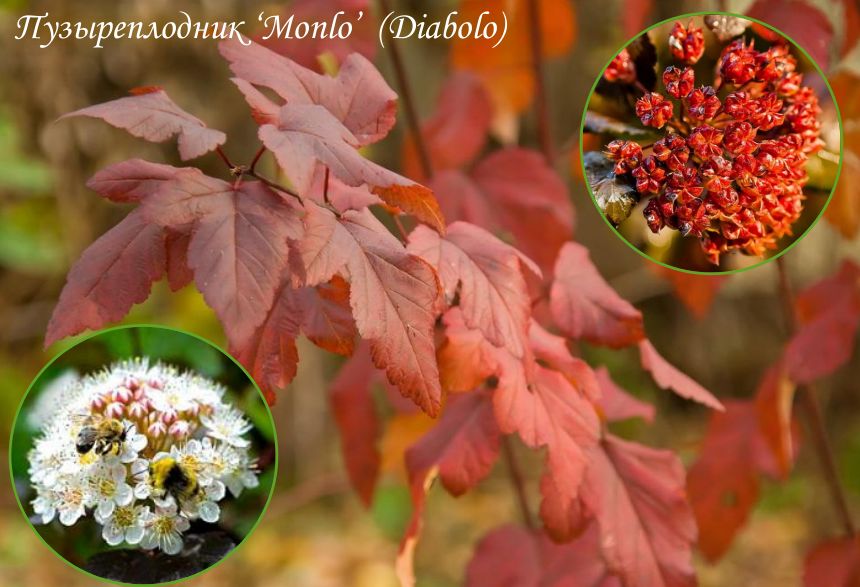
To very hardy and fast growing shrubs, with spectacular foliage coloration are the same vesicles viburnum (Physocarpus opulifolius). For example, the variety " diabolo » with purple-red leaves (up to 2 m high), which can be given an ovoid shape by pruning. It can be used as a free growing shrub, as well as planted as a free growing or formed hedge. The same principle applies to the yellow-leaved variety "Luteus". At new frost-resistant varieties with red foliage have now appeared, such as "Diable D'or", "Schutz", "Zdechovice" - with light scarlet, orange (tone nuances depend on the variety) young shoots from spring to mid-summer. Very interesting variety "Red Baron" with dark red, corrugated leaves. The variety "Summer Wine", if the shoots are not cut, pronounced curved branches and beautiful flowering.
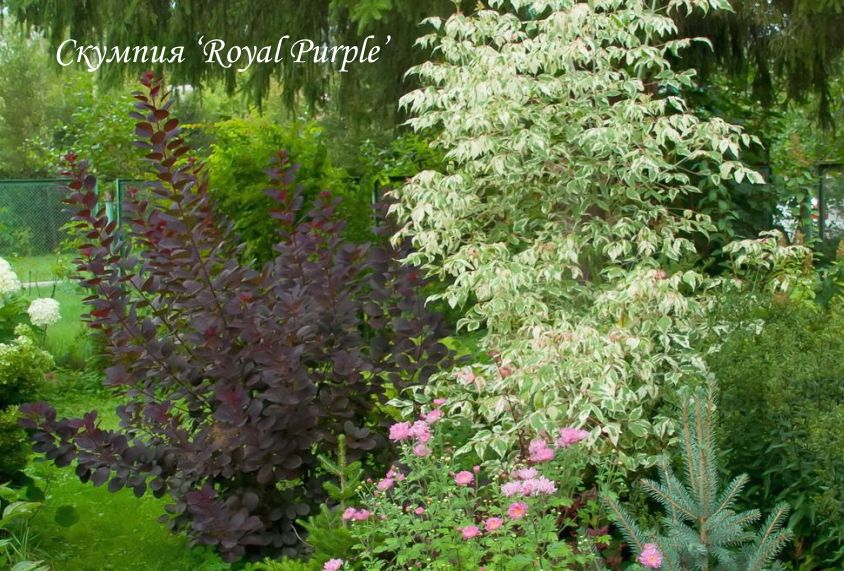

The tannery or wig tree (Cotinus coggygria) variety "Royal Purple" (height up to 2.5 m) is very effective. It is decorative from spring to late autumn thanks to large leaves with an unusual color and original fluffy inflorescences. It requires calcareous soil and good light, needs a protected place, as it has a weaker winter hardiness. Thunberg barberry varieties (Berberis thunbergii) are now very popular in gardens. For example, a variety with bright red leaves, such as "Red Pilar" (up to 1.5 m high) and a variety " Orange Rocket "(height 1.2 m) with reddish-orange foliage, having a very attractive columnar shape. In adult plants, overgrown shoots may form, which are recommended to be cut periodically. The Carmen variety is vigorously growing (height 1.5 m, leaves are bright blood red )," Golden Ring "(height 1.2-1.4 m, leaves are red with a light yellow border). 'Red Chief' (1.2m high) has narrower red-brown leaves and long shoots, while 'Rose Glow' (1.2m high) has purple leaves with white strokes. The lowest (height up to 0.4 m) are varieties "Atropurpurea Nana" (dark purple-red foliage) and " Admiration "(light red foliage with a light golden border). To make the colors of the foliage more pronounced, it is recommended to plant barberries in a sunny place. The foliage of the blooming weigela (Weigela florida) of the "Aleksandra" variety (height 1.2 m) is very interesting, "Victoria" (height 1 m) and "Purpurea Nana" (height 1 m), when blooming it is dark red, later reddish green.Along with the beautiful weigel leaves, it blooms very spectacularly in June.
Shrubs with gray and variegated foliage.
In group compositions or as a separate accent in the garden, undemanding creeping willow (Salix repens) variety "Nitida" (height 1.2 m). It is cut twice a season - in spring and in mid-summer. A very beautiful finely branched shrub can be obtained from purple willow (Salix purpurea f. lambertiana) cultivar "Nana" ("Gracilis") (height 1.5 m) when cut into a hemisphere in early spring. White color always gives the garden a very festive mood, so we can recommend a hardy and easily formed white turf, grade "Elegantissima" (height 2 m). It is very often used in hedges. Willow whole-leaved (Salix integra) 'Hakuro Nishiki' with pronounced white leaf tips is suitable for any accent in the garden. The variety can be grafted, which involves a timely pruning of shoots from a stock or grown from a root offspring, like a bush. Light foliage is formed on young shoots, so pruning is carried out every spring before bud break.



